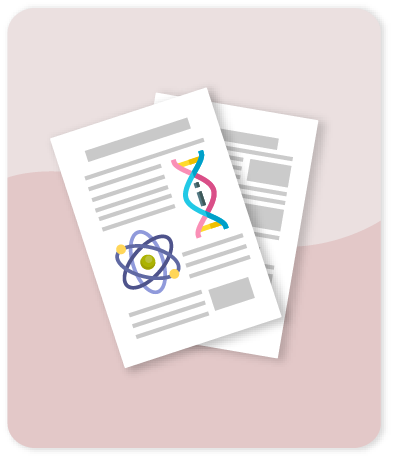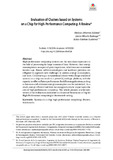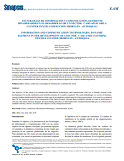Mostrar el registro sencillo del ítem
Memberships Networks for High-Dimensional Fuzzy Clustering Visualization
| dc.creator | Ariza-Jiménez L. | |
| dc.creator | Villa L.F. | |
| dc.creator | Quintero O.L. | |
| dc.date | 2019 | |
| dc.date.accessioned | 2020-04-29T14:53:35Z | |
| dc.date.available | 2020-04-29T14:53:35Z | |
| dc.identifier.isbn | 9783030310189 | |
| dc.identifier.issn | 18650929 | |
| dc.identifier.uri | http://hdl.handle.net/11407/5662 | |
| dc.description | Visualizing the cluster structure of high-dimensional data is a non-trivial task that must be able to deal with the large dimensionality of the input data. Unlike hard clustering structures, visualization of fuzzy clusterings is not as straightforward because soft clustering algorithms yield more complex clustering structures. Here is introduced the concept of membership networks, an undirected weighted network constructed based on the fuzzy partition matrix that represents a fuzzy clustering. This simple network-based method allows understanding visually how elements involved in this kind of complex data clustering structures interact with each other, without relying on a visualization of the input data themselves. Experiment results demonstrated the usefulness of the proposed method for the exploration and analysis of clustering structures on the Iris flower data set and two large and unlabeled financial datasets, which describes the financial profile of customers of a local bank. © 2019, Springer Nature Switzerland AG. | |
| dc.language.iso | eng | |
| dc.publisher | Springer | |
| dc.relation.isversionof | https://www.scopus.com/inward/record.uri?eid=2-s2.0-85075665935&doi=10.1007%2f978-3-030-31019-6_23&partnerID=40&md5=cc5318918e57cf763413520330bcc88a | |
| dc.source | Communications in Computer and Information Science | |
| dc.subject | Clustering visualization | |
| dc.subject | Fuzzy clustering | |
| dc.subject | High-dimensional data | |
| dc.subject | Membership network | |
| dc.subject | Cluster analysis | |
| dc.subject | Complex networks | |
| dc.subject | Data visualization | |
| dc.subject | Fuzzy clustering | |
| dc.subject | Input output programs | |
| dc.subject | Large dataset | |
| dc.subject | Visualization | |
| dc.subject | Cluster structure | |
| dc.subject | Financial profiles | |
| dc.subject | Hard clustering | |
| dc.subject | High dimensional data | |
| dc.subject | High-dimensional | |
| dc.subject | Non-trivial tasks | |
| dc.subject | Simple networks | |
| dc.subject | Weighted networks | |
| dc.subject | Clustering algorithms | |
| dc.title | Memberships Networks for High-Dimensional Fuzzy Clustering Visualization | |
| dc.type | Conference Paper | eng |
| dc.rights.accessrights | info:eu-repo/semantics/restrictedAccess | |
| dc.publisher.program | Ingeniería de Sistemas | |
| dc.identifier.doi | 10.1007/978-3-030-31019-6_23 | |
| dc.relation.citationvolume | 1052 | |
| dc.relation.citationstartpage | 263 | |
| dc.relation.citationendpage | 273 | |
| dc.publisher.faculty | Facultad de Ingenierías | |
| dc.affiliation | Ariza-Jiménez, L., Mathematical Modeling Research Group, Universidad EAFIT, Medellín, Colombia; Villa, L.F., System Engineering Research Group, ARKADIUS, Universidad de Medellín, Medellín, Colombia; Quintero, O.L., Mathematical Modeling Research Group, Universidad EAFIT, Medellín, Colombia | |
| dc.relation.references | Abonyi, J., Babuska, R., FUZZSAM-visualization of fuzzy clustering results by modified Sammon mapping (2004) IEEE International Conference on Fuzzy Systems, 1, pp. 365-370. , https://doi.org/10.1109/FUZZY.2004.1375750, vol., pp | |
| dc.relation.references | Bécavin, C., Benecke, A., New dimensionality reduction methods for the representation of high dimensional omics data (2011) Expert Rev. Mol. Diagn., 11 (1), pp. 27-34. , https://doi.org/10.1586/erm.10.95 | |
| dc.relation.references | Berthold, M.R., Wiswedel, B., Patterson, D.E., Interactive exploration of fuzzy clusters using neighborgrams (2005) Fuzzy Sets Syst, 149 (1), pp. 21-37. , https://doi.org/10.1016/j.fss.2004.07.009 | |
| dc.relation.references | Everitt, B.S., Landau, S., Leese, M., Stahl, D., (2011) Cluster Analysis, , Wiley, Hoboken | |
| dc.relation.references | Feil, B., Balasko, B., Abonyi, J., Visualization of fuzzy clusters by fuzzy Sammon mapping projection: Application to the analysis of phase space trajectories (2007) Soft Comput, 11 (5), pp. 479-488. , https://doi.org/10.1007/s00500-006-0111-5 | |
| dc.relation.references | Fortunato, S., Hric, D., Community detection in networks: A user guide (2016) Phys. Rep., 659, pp. 1-44. , https://doi.org/10.1016/j.physrep.2016.09.002 | |
| dc.relation.references | Francalanci, C., Hussain, A., Influence-based Twitter browsing with NavigTweet (2017) Inf. Syst., 64, pp. 119-131. , https://doi.org/10.1016/j.is.2016.07.012 | |
| dc.relation.references | Fruchterman, T.M., Reingold, E.M., Graph drawing by force-directed placement (1991) Softw. Pract. Exp., 21 (11), pp. 1129-1164. , https://doi.org/10.1002/spe.4380211102 | |
| dc.relation.references | Gajer, P., Goodrich, M.T., Kobourov, S.G., A multi-dimensional approach to force-directed layouts of large graphs (2004) Comput. Geom., 29 (1), pp. 3-18. , https://doi.org/10.1016/j.comgeo.2004.03.014 | |
| dc.relation.references | Gibson, H., Faith, J., Vickers, P., A survey of two-dimensional graph layout techniques for information visualisation (2013) Inf. Vis., 12 (3-4), pp. 324-357. , https://doi.org/10.1177/1473871612455749 | |
| dc.relation.references | Heberle, H., Carazzolle, M.F., Telles, G.P., Meirelles, G.V., Minghim, R., Cell NetVis: A web tool for visualization of biological networks using force-directed layout constrained by cellular components (2017) BMC Bioinform, 18. , https://doi.org/10.1186/s12859-017-1787-5 | |
| dc.relation.references | Höppner, F., Klawonn, F., Visualising clusters in high-dimensional data sets by intersecting spheres Proceedings of 2006 International Symposium on Evolving Fuzzy Systems, EFS 2006 | |
| dc.relation.references | Hu, Y., Shi, L., Visualizing large graphs (2015) Wiley Interdiscip. Rev. Comput. Stat., 7 (2), pp. 115-136. , https://doi.org/10.1002/wics.1343 | |
| dc.relation.references | Ishida, Y., Itoh, T., A force-directed visualization of conversation logs (2017) Proceedings of Computer Graphics International Conference-Cgi 2017, pp. 1-5. , https://doi.org/10.1145/3095140.3095156, pp., ACM Press, New York | |
| dc.relation.references | Jacomy, M., Venturini, T., Heymann, S., Bastian, M., ForceAtlas2, a continuous graph layout algorithm for handy network visualization designed for the Gephi software (2014) Plos ONE, 9 (6), pp. 1-12. , https://doi.org/10.1371/journal.pone.0098679 | |
| dc.relation.references | Leisch, F., A toolbox for K-centroids cluster analysis (2006) Comput. Stat. Data Anal., 51 (2), pp. 526-544. , https://doi.org/10.1016/j.csda.2005.10.006 | |
| dc.relation.references | Leisch, F., Neighborhood graphs, stripes and shadow plots for cluster visualization (2010) Stat. Comput., 20 (4), pp. 457-469. , https://doi.org/10.1007/s11222-009-9137-8 | |
| dc.relation.references | van der Maaten, L., Accelerating t-SNE using tree-based algorithms (2014) J. Mach. Learn. Res., 15, pp. 3221-3245. , http://jmlr.org/papers/v15/vandermaaten14a.html | |
| dc.relation.references | van der Maaten, L., Hinton, G., Visualizing high-dimensional data using t-SNE (2008) J. Mach. Learn. Res., 9, pp. 2579-2605. , http://www.jmlr.org/papers/v9/vandermaaten08a.html | |
| dc.relation.references | Martin, S., Brown, W.M., Klavans, R., Boyack, K.W., OpenOrd: An open-source toolbox for large graph layout (2011) Proceedings of SPIE, P, 7868. , https://doi.org/10.1117/12.871402, January | |
| dc.relation.references | Metsalu, T., Vilo, J., ClustVis: A web tool for visualizing clustering of multivariate data using Principal Component Analysis and heatmap (2015) Nucleic Acids Res, 43 (W1), pp. W566-W570. , https://doi.org/10.1093/nar/gkv468 | |
| dc.relation.references | Newman, M.E.J., The structure and function of complex networks (2003) SIAM Rev, 45 (2), pp. 167-256. , https://doi.org/10.1137/S003614450342480 | |
| dc.relation.references | Pison, G., Struyf, A., Rousseeuw, P.J., Displaying a clustering with CLUSPLOT (1999) Comput. Stat. Data Anal., 30 (4), pp. 381-392. , https://doi.org/10.1016/S0167-9473(98)00102-9 | |
| dc.relation.references | Sato-Ilic, M., Ilic, P., Visualization of fuzzy clustering result in metric space (2016) Proc. Comput. Sci., 96, pp. 1666-1675. , https://doi.org/10.1016/j.procs.2016.08.214 | |
| dc.relation.references | Serra, A., Galdi, P., Tagliaferri, R., Machine learning for bioinformatics and neu-roimaging (2018) Wiley Interdisc. Rev.: Data Min. Knowl. Discov, 8 (5), pp. 1-33. , https://doi.org/10.1002/widm.1248 | |
| dc.relation.references | Sharko, J., Grinstein, G., Visualizing fuzzy clusters using RadViz (2009) Proceedings of International Conference Information Visualisation, pp. 307-316. , https://doi.org/10.1109/IV.2009.74, pp | |
| dc.relation.references | Wang, K.J., Yan, X.H., Chen, L.F., Geometric double-entity model for recognizing far-near relations of clusters (2011) Sci. China Inf. Sci., 54 (10), pp. 2040-2050. , https://doi.org/10.1007/s11432-011-4386-5 | |
| dc.relation.references | Wang, W., Zhang, Y., On fuzzy cluster validity indices (2007) Fuzzy Sets Syst, 158 (19), pp. 2095-2117. , https://doi.org/10.1016/j.fss.2007.03.004 | |
| dc.relation.references | Xu, R., Wunsch, D., Survey of clustering algorithms (2005) IEEE Trans. Neural Netw., 16 (3), pp. 645-678. , https://doi.org/10.1109/TNN.2005.845141 | |
| dc.relation.references | Xu, R., Wunsch, D.C., Clustering algorithms in biomedical research: A review (2010) IEEE Rev. Biomed. Eng., 3, pp. 120-154. , https://doi.org/10.1109/RBME.2010.2083647 | |
| dc.relation.references | Zhou, F., A radviz-based visualization for understanding fuzzy clustering results (2017) Proceedings of 10Th International Symposium on Visual Information Communication and Interaction, pp. 9-15. , https://doi.org/10.1145/3105971.3105980, pp., ACM, New York | |
| dc.type.version | info:eu-repo/semantics/publishedVersion | |
| dc.type.driver | info:eu-repo/semantics/article |
Ficheros en el ítem
| Ficheros | Tamaño | Formato | Ver |
|---|---|---|---|
|
No hay ficheros asociados a este ítem. |
|||
Este ítem aparece en la(s) siguiente(s) colección(ones)
-
Indexados Scopus [1632]



